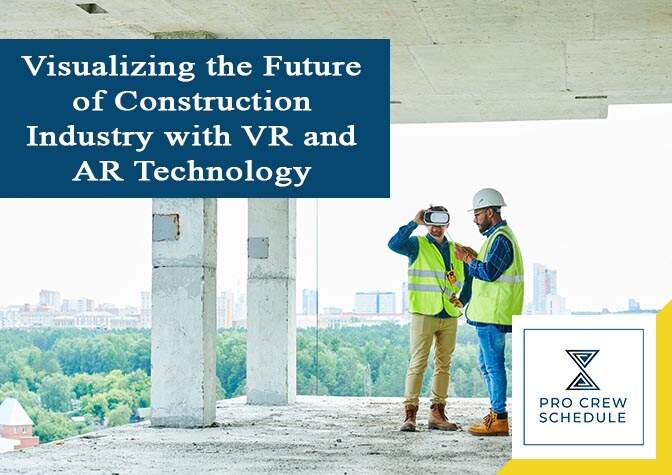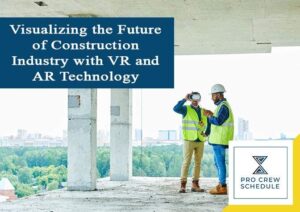Years ago, the construction industry was relatively slow in accepting technological changes, but today it becomes an early adopter of the two most advanced technologies in existence. As VR (virtual reality) and AR (augmented reality), technologies continue to acquire more and more traction in consumer software and gadgets; numerous professional and industrial markets are a bit faster on the uptake.
As various AR and VR forms find their way into construction, the industry has already been wrestling with construction technology and ways to get machines and humans to interact better. Today, the construction industry is up against the increasing regulatory complexities. But with the application of VR and AR, construction workers gain visions and insights from these technologies as it changes how things work on-site. Many industry commentators are continuously discussing the advantages of VR and AR in the business for many years.
So for this blog, we’re about to discover the immense impact of VR and AR in the industry.
What’s the Major Difference between VR and AR?
AR has the Potential to Further Improve Project Efficiency.
The developers are widely using VR to observe and review real 3D environments of any architectural designs. Utilizing a mix of immersive VR headsets and Building Information Modeling (BIM) technology, project managers, engineers, architects, and others closely involved in the project can spot design flaws. In that way, it can be easier for them to better plan out the approach before constructing it.
This technology has great potential in helping builders and developers in avoiding expensive change orders. Unfortunately, $15.8 billion is wasted each year due to poor data use in the construction industry.
- AR presents outstanding phenomenal advantages in the industry and construction crew scheduling software for project management. Several AR applications can interpret and see the external world in real-time to project images into it. Some software companies such as Microsoft have already publicly released a proof of concept for this application. AR-enabled glasses from Microsoft serves as a tool for any construction projects by removing the need for physical blueprints.
- AR’s interfacing ability with the Building Information Model (BIM) needs to be precise. It has to be over-lay within eight inches of accuracy. Otherwise, some AR elements won’t line up with any actual ones, and things might look off. However, it wasn’t an issue from a technical perspective. Apparently, there are other serious safety risks involved in the whole set-up.
- Any AR technologies can be distracting at some point. In an active construction site, small distractions might cause serious injuries or, worst, a sudden death. With this being said, this technology should be necessarily precise and carefully designed to make sure that it seamlessly integrates with the actual environment in the least distracting and safest way.
VR is Opening New Doors for Designers, Builders, and Architects
On the other hand, AR projects virtual images to the user’s line of sight. Therefore, it is proven to have the potential to be utilized on-site to manage construction and create structures exactly as design. It could significantly speed up construction projects and reduce the number of mistakes during the actual building process. Moreover, AR can further analyze designs and layouts and even predict issues before the real job begins, allowing problems to be identified and cored before ground breaks.
However, the technology itself is still in its development stages. Yet, many industry leaders haven’t stopped imagining the many ways this technology might transform the industry shortly.
- VR is already proving to be an instrumental rendering and planning tool. By providing a virtual and immersive environment, architects can obtain a better sense of spacing before it physically exists, allowing them to make more accurate and informed design decisions. Additionally, it guarantees firms to create more compelling cases when making a bid for newer projects. It is much better instead of presenting a two-dimensional rendering model.
- The main point is that as the entire level of complexities and demands in the modern building continues to expand and increase, embracing VR and AR alongside other innovative technologies will be the main key to maintaining competitiveness, keeping the head above water. By default, if anyone prefers to forge ahead, starting to take better advantage of the latest and impactful tools at the disposal is a must-do.
How AR and VR Impact the Construction Industry?
New tech-platforms are altering things up for most traditional trades from construction schedule software to market networks – and the resulting impact is massive. Virtual reality and Augmented Reality are two-tech trends surrounded by a significant amount of hype over the years. But what exactly these technologies are and how they are improving the construction industry.
1. Real-Time Project Information
Thanks to VR and AR, field workers can walk through the job site anytime and observe how the completed project will look. This technology helps a building that has an empty shell to come to life. Expect that there will be the style and size of doors and windows, locations, and building systems. Using the AR headset and VR technology, workers can see all of the details in another dimension.
Comparisons and similarities can be identified and observed further. Thus, it will be easier for them to analyze the building plan and ensure that everything is in order. It can cut the time spent resolving minor mistakes and incorrect positioning of a window and doors.
2. Detecting Errors
Both AR and VR enable the construction team to identify errors ahead of time. Thus, avoiding costly mistakes is much easier. VR technologies allow site designs to be created into ascended virtual models that can be walked-through. Amending and checking errors in the plans even before the construction can be done in this way. On the other hand, AR can significantly help in terms of generating real-time visitations of any project.
With Augmented Reality, architects are holding up or using tablets and smartphones with the camera facing the site. Viewing any scaled-up models of the design can be much easier using this.
3. Enhancing Team Collaboration
Both Virtual Reality and Augmented Reality enhance collaboration among team members and project stakeholders before the construction job begins. A much-improved communication is also one of the benefits as it is considered a crucial part of successful projects. A contractor or construction manager can use Augmented Reality to do a walkthrough site inspection while viewing a BIM model.
Any of the construction team can immediately record a video or take pictures from where the AR walkthrough. The design team can receive the files and will clarify if there are occurring issues.
4. Improving Construction Safety Standards
Job safety on-site can be greatly improved through VR and AR tech applications. Both of these technologies can be utilized to enhance the awareness of on-site conditions without physically subjecting any construction managers and workers to safety hazards. In fact, VR immersion safety training courses are now implemented in some construction firms. Implementing such training courses can simulate users in terms of dangerous circumstances or intensive procedures.
Apparently, these training courses’ usage data can be gathered and combined with safety records, geographic data, and other related requirements to optimize real-world practices and safety programs further.
5. Handover and Commissioning
Many cloud services and mobile punch list apps have made the closing out process more efficient than the paper-based equivalent. Likewise, commissioning tends to require tons of information and documents on building systems. VR and AR apps can bring any specifications alongside the actual performance metrics; this data is needed just in time.
Handling over a specific project to the clients is another phase where VR and AR can be used. An interactive user’s guide and building owner’s manual could add significant value over the building’s life cycle. It is also wise to take note of some serious challenges when using a property-related app. While technology develops so fast, apps become more out-of-date in a short time.
6. More Precise Engineering and Architectural Designs
Designers use video or image montages to show how materials, buildings, or furniture will place in a pre-existing environment. Using AR, the designers can directly overlay an interactive design to the models in a live and real environment. Project team members don’t need any unique tool or equipment to utilize AR on-site. For instance, Augment uses smartphones and tablets as AR devices.
Seeing things on a vast scale is very helpful, even for any experienced designer. This type of technological opportunities will lead to any innovations in construction and design.
Key Takeaways
Virtual Reality and Augmented Reality are both still in the early deployment stage. The implementation costs on the industry scale always somehow outweigh the advantages. Nonetheless, there is an immense and more significant potential for the utilization of both technologies in the industry. All project leaders and construction business owners are looking forward to the many advantages these techs will offer. VR and AR integration in construction is rising today, and these are the latest techs to keep a close eye on!







